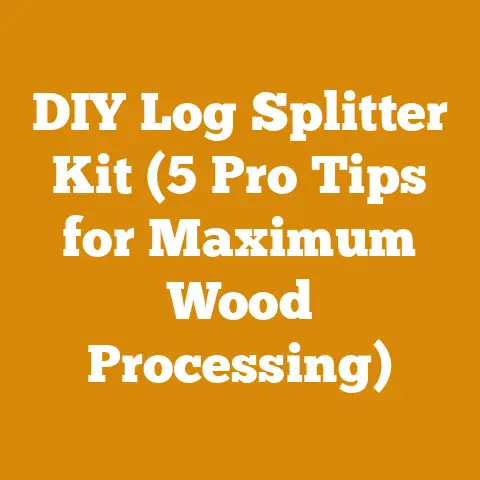Hickory Blanks for Axe Handle: Best Wood Choice? (Pro Insight)
The quest for a perfect axe handle is a timeless endeavor, one that connects us to generations past who relied on these tools for survival and craftsmanship. But is hickory the undisputed king, and how do we navigate the often-murky waters of cost when sourcing the right hickory blanks? Let’s dive in and get you the pro insight you need.
Hickory Blanks for Axe Handle: Best Wood Choice? (Pro Insight)
Choosing the right wood for an axe handle is more than just aesthetics; it’s about safety, durability, and performance. Hickory, with its exceptional strength and shock resistance, has long been the go-to choice for many. But what makes hickory so special, and how do you determine if it’s truly the best option for your needs? Furthermore, how do we navigate the costs associated with sourcing quality hickory blanks?
Why Hickory? A Deep Dive into Material Properties
Hickory isn’t just a name; it’s a family of hardwoods, each with slightly different properties. Shagbark hickory and pecan hickory are two common varieties, but the “true” hickories (like shagbark) generally offer superior strength.
- Strength: Hickory boasts impressive bending strength, crucial for absorbing the impact of each swing.
- Shock Resistance: This is where hickory truly shines. Its ability to absorb shock minimizes hand fatigue and reduces the risk of handle breakage.
- Durability: Hickory is a dense wood, making it resistant to wear and tear.
- Grain Orientation: A straight, tight grain is essential for an axe handle. It provides maximum strength along the length of the handle and minimizes the risk of splitting.
However, finding the right hickory blank isn’t always straightforward. Factors like the tree’s growth rate, the location within the tree from which the blank was cut, and the drying process all play a role in the final product’s quality.
The Cost of Quality: Understanding Hickory Blank Pricing
Okay, let’s talk brass tacks. The cost of hickory blanks can vary dramatically based on several factors:
- Wood Grade: This is paramount. A “premium” grade blank, free from knots, defects, and with a straight grain, will command a higher price. “Select” or “Common” grades will be less expensive but may require more careful selection and potentially more waste.
- Dimensions: Obviously, larger blanks cost more. Consider the size of your axe head and the desired handle length when determining the necessary dimensions.
- Source: Where you buy your blanks significantly impacts the price. Direct from a sawmill, a specialty woodworking supplier, or online marketplaces each offer different pricing structures.
- Drying Method: Air-dried blanks are generally considered superior to kiln-dried blanks for axe handles, as the slower drying process reduces stress within the wood. However, air-dried blanks often cost more and require longer lead times.
- Quantity: Purchasing in bulk usually results in a lower per-blank cost. This is a consideration if you plan to make multiple handles or foresee future projects.
My Personal Experience: I once sourced a batch of hickory blanks from a local sawmill after a storm had brought down a large shagbark hickory. While the price was incredibly attractive (about $5 per blank, rough cut), the amount of work involved in selecting usable pieces, milling them to the correct dimensions, and then air-drying them for several months was considerable. The “cheap” blanks ended up costing me a significant amount of time and effort. I learned a valuable lesson: sometimes, paying a little more upfront for a quality blank saves you money in the long run.
Data and Statistics: According to data from the US Forest Service, the average price for kiln-dried hickory lumber (4/4 thickness, FAS grade) ranges from $4 to $7 per board foot. This translates to roughly $15-$30 for a single axe handle blank, depending on dimensions. Air-dried blanks can be even more expensive, often fetching a premium of 20-30%. Keep in mind that these are national averages, and local prices can vary.
Cost Breakdown Example:
Let’s break down the potential costs for a single hickory axe handle blank:
- Premium Grade, Kiln-Dried, Purchased Online: $25 – $40
- Select Grade, Kiln-Dried, Purchased from a Local Supplier: $18 – $30
- Rough-Cut, Air-Dried, Purchased from a Sawmill: $5 – $15 (plus significant labor and drying time)
These are just estimates, of course. To get a more accurate picture, I recommend contacting several suppliers in your area and requesting quotes.
Beyond Hickory: Exploring Alternative Wood Choices
While hickory is the traditional choice, other hardwoods can be suitable for axe handles, especially if hickory is unavailable or cost-prohibitive.
- Ash: Another strong and shock-resistant wood, ash is a good alternative to hickory. It’s generally lighter in color and slightly less dense.
- Maple: Hard maple can be used, but it’s not as shock-resistant as hickory or ash. Soft maple is generally not suitable for axe handles.
- Oak: White oak is a durable and readily available wood, but it tends to be less flexible than hickory.
- Hornbeam (Ironwood): This wood is incredibly dense and strong, but it can be difficult to work with.
Cost Comparison: Ash and maple are typically less expensive than hickory, while oak can be comparable in price. Hornbeam, if you can find it, may be more expensive due to its rarity and difficulty in processing.
Cost Optimization Strategies: Saving Money Without Sacrificing Quality
Now, let’s talk about how to save money without compromising the quality of your axe handle.
- Buy in Bulk (If Possible): As mentioned earlier, purchasing multiple blanks at once can often result in a lower per-blank cost. Consider splitting an order with friends or fellow woodworkers.
- Consider Lower Grades (Carefully): A “select” or “common” grade blank can be perfectly acceptable if you’re willing to carefully inspect it and work around any minor defects.
- Source Locally: Buying from a local sawmill can often be cheaper than ordering online, especially if you’re willing to do some of the processing yourself.
- Negotiate: Don’t be afraid to haggle, especially if you’re buying in bulk or from a smaller supplier.
- Minimize Waste: Plan your cuts carefully to maximize the yield from each blank.
- Proper Drying: If you choose to air-dry your blanks, ensure they are properly stacked and stickered to prevent warping and cracking. This will minimize waste and ensure you end up with usable wood.
My Experience with Cost Optimization: I once found a local woodworker who was selling offcuts of hickory lumber. These pieces weren’t large enough for furniture making, but they were perfect for axe handles. I was able to purchase a large quantity of these offcuts for a fraction of the price of standard blanks. The downside was that I had to spend more time selecting usable pieces and milling them to the correct dimensions, but the savings were significant.
The Labor Factor: Your Time is Money
Don’t forget to factor in the cost of your own labor. If you’re spending hours milling and shaping a blank, that time has value. Be realistic about your skills and the amount of time you’re willing to invest. Sometimes, it’s simply more cost-effective to buy a ready-to-use blank, even if it costs a bit more upfront.
Estimating Labor Costs: Consider what your time is worth per hour. If you value your time at $25 per hour and spend 4 hours shaping and finishing an axe handle, that’s $100 in labor costs. Add that to the cost of the blank to get a true picture of the total cost.
Tooling Costs: Chainsaws, Drawknives, and More
The tools you use to shape and finish your axe handle also contribute to the overall cost.
- Chainsaws: If you’re sourcing rough-cut blanks, you may need a chainsaw to cut them to size.
- Drawknives: A drawknife is essential for shaping the handle.
- Spokeshaves: Spokeshaves are used for refining the shape and creating a smooth surface.
- Rasps and Files: These are used for final shaping and smoothing.
- Sandpaper: Various grits of sandpaper are needed for finishing.
- Finishes: Linseed oil, varnish, or other finishes are used to protect the wood and enhance its appearance.
Cost Considerations: If you don’t already own these tools, you’ll need to factor in their cost. High-quality hand tools can be expensive, but they’ll last a lifetime if properly cared for. Consider buying used tools to save money.
Tool Maintenance: Don’t forget about the cost of maintaining your tools. Chainsaws need sharpening and occasional repairs, and hand tools need to be kept clean and sharp.
The Environmental Factor: Sustainable Sourcing
While not directly related to monetary cost, it’s important to consider the environmental impact of your wood sourcing. Choose suppliers who practice sustainable forestry and harvest wood responsibly. Look for certifications like the Forest Stewardship Council (FSC).
The True Cost: The cheapest wood isn’t always the best choice, especially if it comes from unsustainable sources. By supporting responsible forestry practices, you’re investing in the long-term health of our forests and ensuring that future generations will have access to quality wood.
Drying Time Calculations: Patience is a Virtue
If you opt for air-drying your hickory blanks, understanding drying times is crucial. The drying time depends on several factors, including:
- Wood Thickness: Thicker blanks take longer to dry.
- Air Circulation: Good air circulation is essential for even drying.
- Humidity: High humidity slows down the drying process.
- Temperature: Warmer temperatures speed up drying.
Estimating Drying Time: As a general rule of thumb, air-drying hardwoods takes about one year per inch of thickness. So, a 2-inch thick blank could take up to two years to dry properly.
Accelerated Drying: While kilns are used to accelerate the drying process, they can also cause stress in the wood. A slower, more gradual drying process is generally preferred for axe handles.
Moisture Content: The ideal moisture content for an axe handle is around 10-12%. You can use a moisture meter to check the moisture content of your blanks.
Legal Considerations: Permits and Regulations
In some areas, you may need permits to harvest wood from public lands or to transport timber across state lines. Check with your local authorities to ensure you’re in compliance with all applicable laws and regulations.
The Cost of Non-Compliance: Ignoring these regulations can result in fines and other penalties. It’s always better to be safe than sorry.
Regional Price Variations: Location, Location, Location
The cost of hickory blanks can vary significantly depending on your location. Areas with abundant hickory forests will generally have lower prices than areas where hickory is scarce.
Research Your Local Market: Contact local sawmills, woodworking suppliers, and lumberyards to get a sense of the prevailing prices in your area.
Case Studies: Real-World Examples
Let’s look at a couple of case studies to illustrate the cost considerations involved in sourcing hickory blanks.
Case Study 1: The Hobbyist Woodworker
A hobbyist woodworker wants to make a single axe handle. They purchase a premium-grade, kiln-dried hickory blank online for $35. They already own the necessary tools. Their total cost is $35 plus shipping.
Case Study 2: The Small-Scale Logger
A small-scale logger wants to make multiple axe handles to sell at a local craft fair. They source rough-cut hickory blanks from a local sawmill for $8 each. They spend several hours milling and shaping each blank. Their total cost per handle is $8 (blank) + $20 (labor) + $2 (tool maintenance) = $30.
These are just two examples, of course. Your own costs will vary depending on your specific circumstances.
Budgeting for Your Axe Handle Project
Creating a budget is essential for any woodworking project. Here’s a step-by-step guide:
- Determine Your Needs: What size axe handle do you need? What grade of wood are you willing to use?
- Research Prices: Contact several suppliers to get quotes for hickory blanks.
- Factor in Labor Costs: How much time will you spend on the project? What is your time worth?
- Account for Tooling Costs: Do you need to purchase any new tools? What are the maintenance costs for your existing tools?
- Add a Contingency: It’s always a good idea to add a contingency to your budget to cover unexpected expenses.
Example Budget:
- Hickory Blank: $25
- Labor (4 hours at $25/hour): $100
- Tool Maintenance: $5
- Contingency (10%): $13
- Total Budget: $143
Actionable Takeaways and Next Steps
So, you’ve got the pro insight. What are your next steps?
- Assess Your Needs: Determine the specific requirements for your axe handle.
- Research Suppliers: Contact local sawmills, woodworking suppliers, and online marketplaces to get quotes.
- Create a Budget: Develop a detailed budget that includes all costs, including materials, labor, and tooling.
- Source Your Materials: Purchase your hickory blank and any necessary tools.
- Get to Work! Start shaping and finishing your axe handle.
By following these steps, you’ll be well on your way to creating a high-quality axe handle that will last for years to come.
Final Thoughts: The Value of a Well-Crafted Axe Handle
In the end, the cost of a hickory blank is just one factor to consider. A well-crafted axe handle is an investment in safety, durability, and performance. It’s a tool that will serve you well for years to come. Don’t be afraid to spend a little more to get a high-quality blank. The peace of mind and the improved performance are well worth the investment. And remember, the satisfaction of creating something with your own hands is priceless. So, get out there, find the perfect hickory blank, and start crafting! The timeless tradition awaits.






